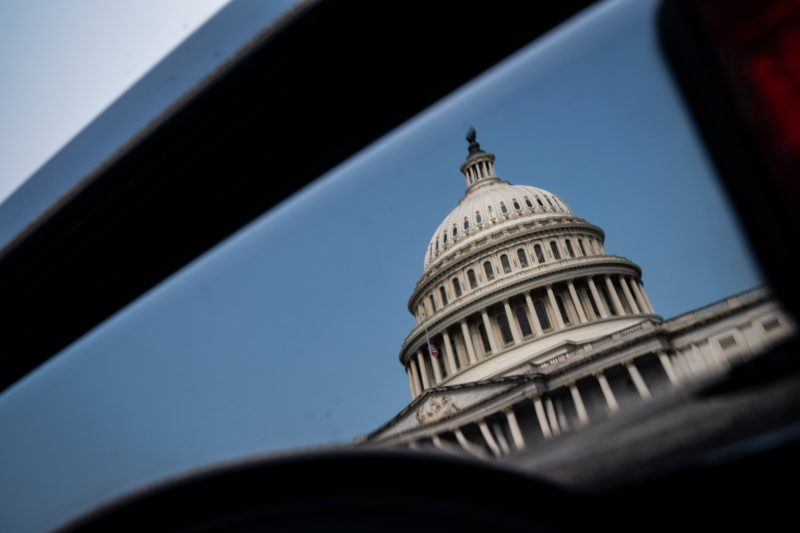Lawmakers are racing to beat fast-approaching government shutdown deadlines in March, but deep policy divisions may slow them down on everything from passenger rail funding to Internal Revenue Service resources to support for the World Health Organization.
The big questions about total spending are settled already: House Speaker Mike Johnson (R-La.) and Senate Majority Leader Charles E. Schumer (D-N.Y.) reached a $1.66 trillion government funding deal in January, in line with a framework President Biden and then-Speaker Kevin McCarthy (R-Calif.) agreed to last spring. Late last month, negotiators also agreed to allocate spending limits for all 12 appropriations bills, or year-long spending legislation, for the rest of the 2024 fiscal year, which ends on Sept. 30.
But the House and Senate remain bitterly divided on how to disburse some of that money. The Democratic-controlled Senate largely wrote its spending bills to adhere to Biden and McCarthy’s deal. The Republican-run House wrote its bills planning for steep funding cuts, and the House also included dozens of contentious policy provisions — called “riders” because they ride along in often unrelated legislation.
On top of those provisions, some of the House’s bills would also rework entire federal agencies or programs by slashing funding, essentially enacting broad new policies by snapping shut the federal government’s purse. The total spending for a federal department might be the same, but the bills vary widely on what each chamber would allow the government to do.
The House bill to fund the Transportation Department, for instance, includes a 64 percent cut to Amtrak and rescinds $25 billion from the IRS. The appropriation for the State Department bans the federal government from funding the World Health Organization or the president’s chief climate diplomat and reduces Secretary of State Antony Blinken’s salary to $1.
The bill for the Interior Department slashes the Environmental Protection Agency’s budget by 40 percent. The financial services appropriation claws back another $10 billion from the IRS and eliminates funding for state election security grants.
A law setting temporary spending levels expires soon, with about 20 percent of the government set to run out of funding March 1 and 80 percent on March 8. Now House and Senate negotiators must reconcile all 12 bills so they can pass both chambers to fund operations for the full year — but lawmakers are starting that process gravely divided. If they can’t make progress by the deadlines, Congress will probably have to pass another temporary extension this month or face at least a partial shutdown.
Johnson made clear after agreeing to the $1.66 trillion top-line spending number with Schumer that Republicans would aim to keep the policy provisions the House has adopted. The House passed seven of the 12 appropriations bills; the Senate passed only three.
“We’ve stated our priorities on paper. We passed some very important measures in those appropriations bills that we sent to the Senate that have been sitting there collecting dust,” Johnson said in January. “There’s a lot of disagreement between the two chambers on what those policies are and what those priorities are, and that’s what this process is about. Our appropriators and theirs get in a room, they roll up their sleeves and they arm-wrestle over what those differences are and they reach consensus.”
House Republicans pursued non-spending-related policy riders to prevent federal agencies from implementing Biden administration climate change rules, policies that conservatives say over-regulate the energy and manufacturing industries, and to prohibit any federal resources from going to Planned Parenthood and other health care providers who perform abortion procedures.
The House GOP also pursued legislation to stop U.S. embassies from flying LGBTQ pride flags and to ban drag performers on military bases.
These culture war-style riders, lawmakers of both parties say, are easy for negotiators to leave out of final legislation. They’re frequently added to force opponents into politically embarrassing votes or to signal priorities to constituents. And in a divided Congress, where the leaders of both chambers need help from the minority party to pass legislation, messaging bills are rarely part of finished legislative products.
“We’re not going to buy that stuff. We’re not going to vote for it. If they have the votes, fine. But they don’t have the votes. They need us. They’re either going to be responsible or they’re not,” Rep. Steny H. Hoyer (Md.), Democrats’ top negotiator on the financial services bill, told The Washington Post.
But dramatic appropriations differences — essentially policymaking through spending — are much more potent at the negotiating table and would have far wider consequences if enacted.
The proposed cuts to Amtrak would force the rail service, which served 28.6 million passengers in the 2023 fiscal year, to “radically reduce or suspend service on various routes across the nation,” chief executive Stephen Gardner said in a statement.
The WHO cuts could also prove devastating. The United States provided $1.3 billion of the global health agency’s nearly $6.73 billion in its latest two-year budget, according to the group’s financial disclosures. Without even a portion of that funding, the global health organization — which tracks and treats emerging and chronic illnesses such as covid-19, HIV/AIDS and malaria — would be severely limited.
Funding reductions to the IRS would cut off the Biden administration’s agency expansion — plans to hire thousands of customer service representatives to staff agency phone help lines, and hundreds of enforcement experts to increase tax scrutiny on corporations and high-wealth individuals.
“We go over and we argue for everything that’s passed the House that’s in our bills. We know we’re not going to get them all. The Senate does the same thing. They know they’re not going to get everything they want. Then you start trading. And you try to keep the things that are important to you or important to a majority of your members,” said Rep. Mike Simpson (Idaho), House Republicans’ top negotiator on the Interior Department bill.
Disputes among the GOP over some of those provisions prevented Johnson and his predecessor McCarthy from even passing some bills through the House. Republicans from the Northeast rejected the Transportation Department appropriation over the Amtrak cuts.
“You can’t generate leverage by saying, ‘I’m going to zero out your priority,’ especially if it’s public infrastructure. Just because your home state doesn’t need it doesn’t mean you get to put a number that is preposterously low,” Sen. Brian Schatz (D-Hawaii), the chief Senate negotiator on the transportation bill, told The Post. “No one takes any of that seriously, and when it’s time to try to reach a compromise, you try to find savings where you can, but any violence that you do to members’ priorities loses you votes. You can’t really cut Amtrak and expect to pass an appropriations bill.”
Schatz added that Rep. Tom Cole (Okla.), his House GOP counterpart negotiating the transportation bill and one of the longest-tenured appropriators in Congress, was “a prince.”
“The problem is the numbers. The problem is not goodwill or cooperation,” Schatz said.



























